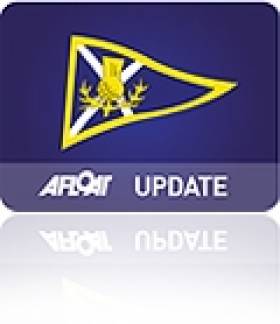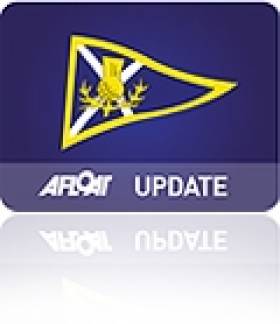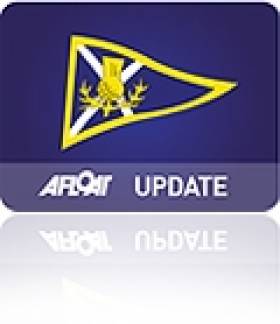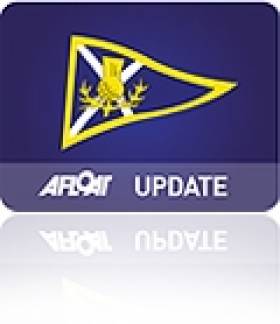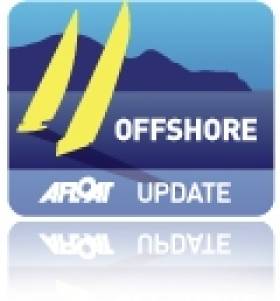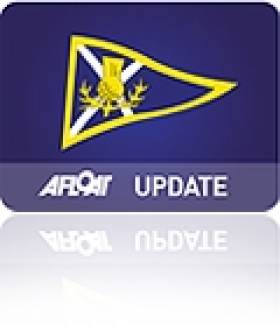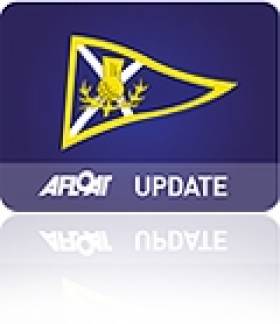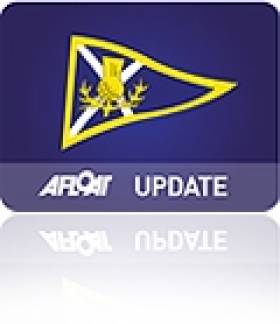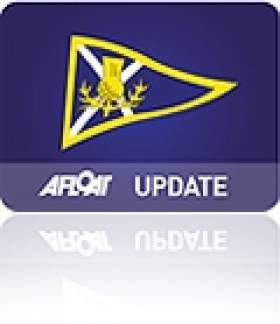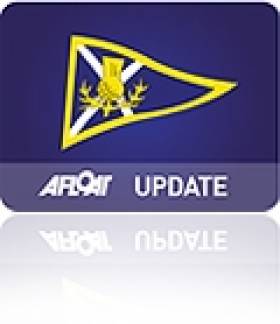Displaying items by tag: scottish series
Forecasting Sea, Sun & Sailing for Scottish Series
#scottishseries – The fleet of close to 100 boats will start four days of competitive racing on Friday 23 May. With a number of coveted trophies on the table that will need tactics, skill and experience to win.
Separated into classes the yachts sail with those of similar size, speed and design. The One design classes like the Sigma 33's will definitely deliver close results. Last years winners Sigmatic are back to defend their title and Mayrise who took second place, after a series finish on equal points, is ready to fight back. The same result is true of IRC Class One yachts Zephyr and Roxstar who will be tussling for line honours and keeping ahead of a very competitive fleet of fine yachts. Eyes will be on current IRC Class 2 champion Salamander XXl whose skipper John Corson is believed to be one of a select few who has competed in all 40 Scottish Series events. Can Salamander XXl win the overall trophy as in 2010 or could this be a year for Jonathan Anderson's Roxstar to get a 4th win of this prestigious trophy as the event celebrates its 40th anniversary? The event is steeped in history and it is a very significant year to have your name engraved on the silverware.
The social plans for the event, after the tensions of a day's racing, will ensure there is fun shoreside. The bars and restaurants will be ready to provide much needed refreshments and food. The event marquee will host a daily prize-giving, 1830 -1930hrs, followed by live music 2100 – 0100hrs by local band Dance to the Democrats. Marking the 40th celebrations will be a gathering for all participants on Saturday 24th from 5pm. This will be supported by sponsors McEwan's and Botanist Gin, and will feature an anniversary cake provided by a stoic supporter of the regatta, Tunnocks Bakery. It doesn't stop there – fireworks on Saturday evening will light up Tarbert village. Throughout the weekend there will be dinghy sailing sessions coordinated by Stramash while an array of local produce and workshops will be available around the picturesque village.
Race schedule:
Friday 23 May. Start A – Gourock
Start B – Tarbert Loch Fyne
Conclusion of days racing: Tarbert Loch Fyne for all classes.
Subsequent races: Loch Fyne. Scheduled start time daily is 11:00hrs.
Yachts will be berthing in Tarbert Harbour and Portavadie Marina.
Scotland's most best known yacht racing regatta has announced headline sponsors Silvers Marine. The new owners of the iconic Scottish Boatyard Silver Hills, Rosneath, have confirmed their support and sponsorship for the 40th Anniversary of the Scottish Series Regatta.
The event, organised by the Clyde Cruising Club (CCC), has gained much recognition over the years and will be celebrating 40 years of success as Silvers Marine Scottish Series 2014. Hosted in the west coast village of Tarbert Loch Fyne this is a popular event for sailors from Scotland, Ireland, England and abroad.
Rhu, based GSS Group very recently concluded the purchase of Silvers Marine. Jamie McGarry, owner of GSS Marine Services, says "As a re-launch of the yard and the Silvers brand we are delighted to partner with the CCC in sponsoring the Scottish Series. This is particularly exciting given the 40th celebrations this year in Tarbert. Scottish Series is a magnificent event run by the army of volunteers and club officials from the CCC. To be able to support this and indeed participate in the event is tremendously exciting for all at Silvers and GSS." GSS have already supported other sailing regattas on the Clyde and their involvement will add great value to this event for all in attendance.
The Silvers Marine Scottish Series 2014 will commence with a race from Gourock to Tarbert on Friday 23 May scheduled to start at 10:00hrs. This will be a spectacular site with many yachts tussling on the start line including Ocean Racers Drum and Clyde Challenger. The race programme will then include further races on Loch Fyne on Saturday 24 - Monday 26 May with the Regatta concluding with the prize giving in Tarbert on Monday 26 April after completion of racing.
Scottish Series Celebrates 40th Birthday in 2014
Forty years on and sailors from all round Scotland, Ireland and further afield shall gather from the 23–26 May 2014 to participate in the Scottish Series yacht race organised by the Clyde Cruising Club, CCC. The scenic west coast village of Tarbert, Loch Fyne, aims to welcome over 100 yachts into the harbour where shore side hospitality will be enjoyed as much as the four days of competitive racing.
This event has evolved since its inception in 1973 where it grew from an offshore passage race from the Clyde to Tobermory. Like any good idea that attracts people it has been shaped over the years responding to the sailors, developments in boats and changes in lifestyles. For the 40th celebration the Organiser's have selected key ingredients of the last 4 decades and created an attractive programme, which once again makes this a priority event for yacht sailors.
Recently, shorter and increased quantity of races has been the trend, whereas the series used to have passage races of 200miles! The 2014 racing schedule will not disappoint with the "Clyde Challanger Passage Race" from Gourock to Tarbert. The CCC welcome this sponsorship of the Clyde Challenger and are excited by the inclusion of an offshore, round the world yacht taking part in the event. Skipper Glenn Porter is delighted for the Clyde Challenger to be supporting the opening race of the series. The Royal Gourock Yacht Club has long been involved in the regatta and it is a wonderful sight watching the boats muster in the upper Clyde with crews preparing, sails hoisting, adrenaline pumping as the yachts anticipate the start gun. With action close to shore this offers a great opportunity for spectators to catch a glimpse of the excitement of the sport and skills of the sailors.
The success of this event is owed to commitment and hard work of volunteers and sponsorship of public agency and private sector companies. Event Scotland recognises the importance of this event on the Scottish calendar and Principle Race Officer John Readman reflects on 2013 where " the CCC were very pleased to join with Event Scotland supporting the Year of Natural Scotland 2013. Its emphasis on our natural landscape and the opportunities for outdoor pursuits confirms how fortunate we are to have the Clyde and Loch Fyne on our doorstep."
Ocean sailors venturing south of the equator seek the Roaring Forties for breeze and excitement. There is no doubt that the 40th Scottish Series will be a roaring success and we anticipate sailors and families who have enjoyed it in the past returning along with new friends providing super sailing and showcasing Scotland's scenery and wonderful sailing waters.
#scottishseries – Liam Shanahan's J109 Ruth finished fifth in Class II of the Scottish Series at the weekend, the best of a handful of Irish boats at the Loch Fyne venue this year. Ruth from the National Yacht Club finished fifth from 11 in fleet and two points adrift off Fairlie entry, the Sunfast 37 More Misjif. Galway Class II entry The Gathering was ninth.
Selected overall results of Irish interest are downloadable below as jpeg files for IRC classes 1,2 and 3.
Numbers were way down on the heyday years of 300 plus with just over 80 confirmed this year.
With Antix (Anthony and Peter O'Leary) in offshore mode on the Solent last weekend the Cork yacht did not attend the Clyde leaving the Carrickfergus J133 Jacana ( AB Douglas) as sole Irish entry in class one and finishing seventh from 11 overall.
Though appearing on the entry list the results sheet (see below) suggests Class III Cathal Drohans's Legally Blonde from the Royal St. George YC did not travel. Likewise in class II, Dun Laoghaire's Something else (John Hall) is recorded as Did Not Start.
Neil Marchant's Showgril from Waterfrod Harbour SC was 9th from 14 in class 6.
The Discover Ireland sailing team that featured in WM Nixon's Saturday Sailing blog debuted on Galway bay in the Clarenbridge trophy offshore race yesterday.
The race is sailed over a course from the GBSC start line at Renville to Finis Rock off Inis Oir then onto Canon Rock in the entrance to Rossaveal Harbour before a finish in Renville total distance approx 60 miles.
Yesterday's race saw winds between 25-40 knots which made for a tough beat all the way to Inis oir, but Discover Ireland stretched its lead all the way out of the bay on its nearest competitor "Ibaraki".
Drivers Ben Scallan and Neil Spain made light work of the beat with a full main and a no 4 jib, things eased a little for the fetch up to Rosaveal, but the team still managed to break a kicker and lost instruments temporarily in the lumpy seas encountered.
Then it was kite up in winds which were now sitting between 30-35 knots for a fantastic reach/run home to renville.
Boat speed was sitting above 12 knots the entire time with speeds of up to 18 knots in the heavier gusts.
The boat loved the conditions which is a great reflection on this 15–year–old Stimpson design.
They completed the course in 7 hours 7 minutes in first place and with line honours and the race was an excellent shakedown for a busy season ahead.
The boat's next trip is the delivery to the Scottish series leaving Galway this Friday so skipper Aodhan Fitzgerald is hoping that the present strong westerly flow will abate.
Sadness as Sponsor Pulls Plug on Scottish Series
#scottishseries – Big sponsor of Scottish sailing Brewin Dolphin has announced that it will not be renewing its sponsorship of the Scottish Series sailing event that that has borne its name for 13 years.
Jamie Matheson, Executive Chairman at Brewin Dolphin said "While relinquishing sponsorship of the Scottish Series is tinged with sadness, we're hugely proud of what we, Clyde Cruising Club and participants have achieved over the past 13 years. Our partnership with Clyde Cruising Club has significantly raised the awareness of Scottish sailing across the UK and further afield.
"We would like to wish Clyde Cruising Club the very best for next year's event."
John Watson, Commodore of the Clyde Cruising Club, said, "We would like to thank Brewin Dolphin for their continued support over the past 13 years. It has been one of the longest sports sponsorships in Scotland but as we know all good things must come to an end.
"The Scottish Series is a great event which has something for everyone, from face painting and pipe and dance bands shoreside to stunning scenery and challenging sailing on two event courses on Loch Fyne. Each year, the local community benefits from a substantial boost to its economy as a result of the long-standing event and the input from organisers and sponsors."
J/97 'Fever' Win Scottish Series in Style
#Scottishseries – Over the 38 years of the Scottish Series there have been few prizegivings where the winners of the overall Scottish Series Trophy have composed a more deserving score-line.
With seven wins from as many starts on Loch Fyne, Grant Gordon and his team on the J/97 Fever Glenfiddich not only won each race in IRC Class 3, but they sailed flawlessly to keep two past winners of the premier regatta's top award behind them. Fever, steered by owner Grant Gordon with Tarbert's Ruairidh Scott as tactician, won their class by 12 points ahead of the identical J/97 of Jim Dick which won the Scottish Series Trophy one year ago.
"As an advertisement for this event and for Scottish sailing I don't think you could ask for more than we have had these past few days. It is has been brilliant," said Gordon who was sailing at his third Brewin Dolphin Scottish Series.
An expatriate Scot who has raced internationally with his Fever team, including winning the Swan 45 European Championships with Scott as tactician, Gordon sailed from the Royal Gourock YC as a youngster, and flew the flag of the Clyde Cruising Club on extended family cruises with their Van de Stadt 49 footer Cinderella. He keeps his boat on the south coast of England but raced at Tarbert with a crew which was 75% Scottish, including several who won the Scottish Series Trophy in 2003 with Scott in his 1720 King Quick.
"This is a team of friends that I can rely on, some from university sailing days, some who we wanted to be here because we know they enjoy it, but we came to have fun and so winning here is great," said Ruairidh Scott. "I am so fortunate to go sailing and racing in nice places around the world but it is really special to come back here and race, and winning here is even better. This regatta has been as good as I can remember. And, yes, we all joke about Loch Fyne from time to time, with spinnakers pointing at each other on the same tack, but the winds this time have been really good and the sunshine fantastic."
The winning crew included Grant Gordon, the owner-driver, Ruairidh Scott, Mike Forster, Charlie Cumbley, Ben Fields, Scott Aikman, Angus Stevenson and Stewart Miller. "I am very proud of this team. It has been really magnificent. They have all worked hard and I am grateful for their contribution," said Gordon.
Scott becomes one of the few sailors to have won the overall trophy three times in the skipper, helm or tactician roles, as skipper helm in 2003 on King Quick, and as tactician on Jump Juice in 2007.
Three times winner Jonathan Anderson and his crew sailed a fitting swansong with Playing FTSE which they won IRC Class 1 with on the Beneteau First 47.7's final race outing in their hands.
"The boat goes well when it is windy and so this really was our kind of regatta," said Anderson who finished two points clear of the Forth crew on Absolutely 2.
John Corson won IRC Class 2 on Salamander 2, the First 35 which he bought from France. Stephen Corson commented, "To be honest we were a little surprised to win the class, we did not know how we would do with a new boat. We came here thinking that if we finished in the top half of the fleet we would be happy. But then we were the fastest around the course under IRC yesterday and so that must mean something."
"Overall we are pleased with the performance of the boat, it has good speed all round, though we were a bit more concerned given that the forecast was for very light winds."
The CYCA cruiser-racer classes enjoyed their passage race based diet of races. Winners of CYCA Class 5, Scott Chalmers on Sunrise summarised, "It is hard to remember better racing than we have had here. Yesterday's was just the best race for a long, long time with a good, long hard beat. And it was so nice to see my young son driving all the way."
The Tarbert Shield for the best CYCA boat in the regatta went to Norman Howison and family on Tartan Pimpernel, while the SB20 one design sportsboat class was won by the Irish visitors on Sharkbait.
#SCOTTISHSERIES – It was a distinctly 'old school' day on Loch Fyne for competing crews at the Brewin Dolphin Scottish Series where there was a departure from the usual diet of windward-leeward races and even Olympic triangles. Instead days of old were recalled favourably with a 25 miles passage race up to the south of Loch Fyne around the Inchmarnock Island to a spectator-friendly finish line in front of the entrance to Tarbert's natural harboUr.
If it was a step back in time for some, it was a popular one, even if the odd gripe or two were a blast from the past..... 'a long true beat would have been nice'... 'too much reaching'. But the positive opinions were certainly enhanced by another great day of good breezes, an E'ly which gusted up to 29kts but averaged 16-20kts, ensured Loch Fyne was at its sparkling best and the long reach and run home was a Jubilee procession to salute the Queen.
The brisk conditions proved ideal for Jonathan Anderson's Playing FTSE which was at her best on the stiff upwind, reaching and the powerful downwind. The Beneteau 47.7 was pressed hard on handicap by the Mumm 36 of Kelly and Bramall which finished just 1 minute and 32 seconds behind on corrected time after 3 hrs and 7 mns of racing. Anderson's team are regular class winners and head IRC Class by two points ahead of the Forth crew on Absolutely 2, but light winds for tomorrow's two final races could still upset the class standings here.
Salamander XXI consolidated their lead in IRC Class 2 with a win over Sloop John T to lead their fleet now by three points ahead of Arran's Thomson brothers and their crew on Sloop John T.
For Tarbert's Ruairidh Scott, tactician on Fever Glenfiddich, the J/97, the last time he – like others in the fleet – recalls racing inside Inchmarnock was on the days when the Scottish Series still had an offshore feeder race. Head to head at the island turn with Jackaroo, the current Scottish Series Trophy champions, Fever cut the corner by around ten boat lengths according to Scott, and managed to escape to a comfortable win. They remain unbeaten over all six races so far and might have already put themselves in pole position to win the overall Scottish Series Trophy.
In CYCA Class 5 it was Ian Cameron's Lady Rhona which triumphed, winning by a similar margin on handicap as her sistership Playing FTSE did in the corresponding IRC handicap fleet. Douglas Clow scored a good win in Guilty in CYCA 6, leaving Norman Howison's family crew on Tartan Pimpernel in second.
Day Two Update: Diamond Sailing at Tarbert
#ScottishSeries – Day two of the Scottish seires at Tarbert has offered up a vintage blend of racing. With a full measure more breeze today and constant sunshine, even the SE'ly breeze stayed settled enough to ensure courses on the Bowmore fleet were especially good.
He may have a vested interest, as a representative of Bowmore who loves his Scottish Series, but Playing FTSE's Gordon Dundas came ashore with the unequivocal opinion after posting a sixth and two first places aboard Jonathon Anderson's big Beneteau First 47.7. Their results today takes them three points clear of the Carrickfergus based J/133 Spirit of Jacana.
"It has been the best racing we have had at Tarbert for at least five years." Said Playing FTSE's renowned crew Dundas.
Skippered by three times Scottish Series winner Jonathan Anderson this will be the swansong regatta for Playing FTSE which is being replaced in July after nine years of successful racing.
A lost jib sheet pre-start in the first race was the catalyst of a string of small problems which meant FTSE was one of two boats over the start line early. The second was twice Scottish Series winner Bateleur and then in Class 2 the only skipper in that fleet to have won the top trophy, John Corson, also broke the start ahead of the gun, proved that every second counts on the race course.
Corson and his crew on Salamander XXI rallied after their misdemeanor and came back to win the first race of their three races today, which they backed up with a fourth and a second to lead IRC Class 2 by a single point.
The only boat in the whole regatta to have retained an unblemished scoreline so far is Fever Glenfiddich. Grant Gordon's J/97 posted another three wins today in the brisk 15-20kts breezes to lead by at least 13 points.
"It is good racing. The breezes have been pretty settled but there is certainly enough shifts and changes to keep it interesting and so you have to stay on your toes. The scoreline does not show how close it is and we are definitely being made to work hard." Said Scott.
Indeed in the third race they won by only 48 seconds.
The SB20 fleet of one design Sportsboats which mustered a good sized class, had three great races in the middle of the loch, with the Irish boat Sharkbait of Brian Moran and Ben Durham leading overall by three points.
#SCOTTISH SERIES –With less than three weeks until the start of the Brewin Dolphin Scottish Series which will take place over the Queen's Diamond Jubilee weekend 1 to 4 June on Loch Fyne, event organisers Clyde Cruising Club (CCC) is receiving a steady stream of entries across the classes while the local organisers in Tarbert, Loch Fyne are already well ahead with the infrastructure provision required to host the north of Britain's premier sailing regatta.
Entries are building in strength in the core IRC Classes but also there is increased interest in the CYCA Classes where one of the main attractions over this celebratory holiday weekend is proving to be Sunday 3 June Round Inch race which is open to all-comers as a standalone event. The overall winner of this race is calculated under CYCA handicapping. CCC has noted a growing interest for the simple, picturesque out and back course.
"Really I feel as happy as I can be with the entries so far. This year we decided to offer one level of entry fee with no 'early bird' discount and so we are seeing a steady influx of entries and I feel we will continue to receive entries until the very last minute. Recognising the pressures on owners and crew we have tried to be as adaptable to peoples' needs as possible." Comments John Readman who chairs the Clyde Cruising Club's Brewin Dolphin Scottish Series organising committee.
"And the good news is that we are looking forward to welcoming many boats which we have not seen before."
In Tarbert the preparations are already well under way. A new focal point is guaranteed through the establishment of a new mini regatta village area on the hard standing area which has been created on the north side of the harbour area. With new pontoons presently being put in place, all of the Brewin Dolphin Scottish Series armada will now be hosted on the north side of the harbour rather than on the Fish Quay.
"In fact we will have three marquees which will form a horseshoe shape on the former boatyard site and so we are really starting to benefit from all the infrastructure investment Tarbert has had and the Brewin Dolphin Scottish Series is a great showcase to show it off and to put it to best use." Says John Hardie of Tarbert Enterprise Council.
"Now with this set up we are pretty sure that we will have a place where all the sailors will meet up after racing and enjoy a drink and some chat. Tarbert is really looking forwards to the Diamond Jubilee celebrations with a big Tea Party on the Sunday as well."
"There is a really positive exciting buzz to Tarbert at the moment, better than I remember it for a long time. The waterfront development has been a massive success and the pubs and hotels are now offering a really good range of options. For example, the Anchor Hotel has had a big refurbishment and the Starfish café is popular and doing well, there is so much good choice to be enjoyed. I feel like Tarbert is really stepping up to the plate."


























